Arts & Entertainment Community
Gig Harbor Now and Then: First 3-D movie was a ‘stupendous, thrilling novelty’
At the end of our previous Gig Harbor Now and Then column, we invited readers to post their opinions on the Gig Harbor Now Facebook page, addressing the question of whether or not the city of Gig Harbor should take an active interest in correcting its very inaccurate little city park histories and its many history placards scattered around town. The city administrators should be pleased that as of the writing of this column, 12 days later, not a single reader has posted an opinion of any kind. That can easily be taken as reason enough not to make any corrections. If the public doesn’t care, why waste the money?
Community Sponsor
Community stories are made possible in part by Peninsula Light Co, a proud sponsor of Gig Harbor Now.
Our previous Gig Harbor Now and Then questions of local history concern Gig Harbor’s first motion picture theater. The first question, a two-parter, is:
In what year did Gig Harbor’s original movie theater show its first 3-D movie, and what was the name of the film?
Answer: 1925, on July 12.
The name of the silent, short film was “Luna-cy!” (including the exclamation point). Filmed at Luna Park on Coney Island, it was the first in a four-film series called Stereoscopiks. The shorts were produced by Ives and Leventhal, and released by Pathé Films.
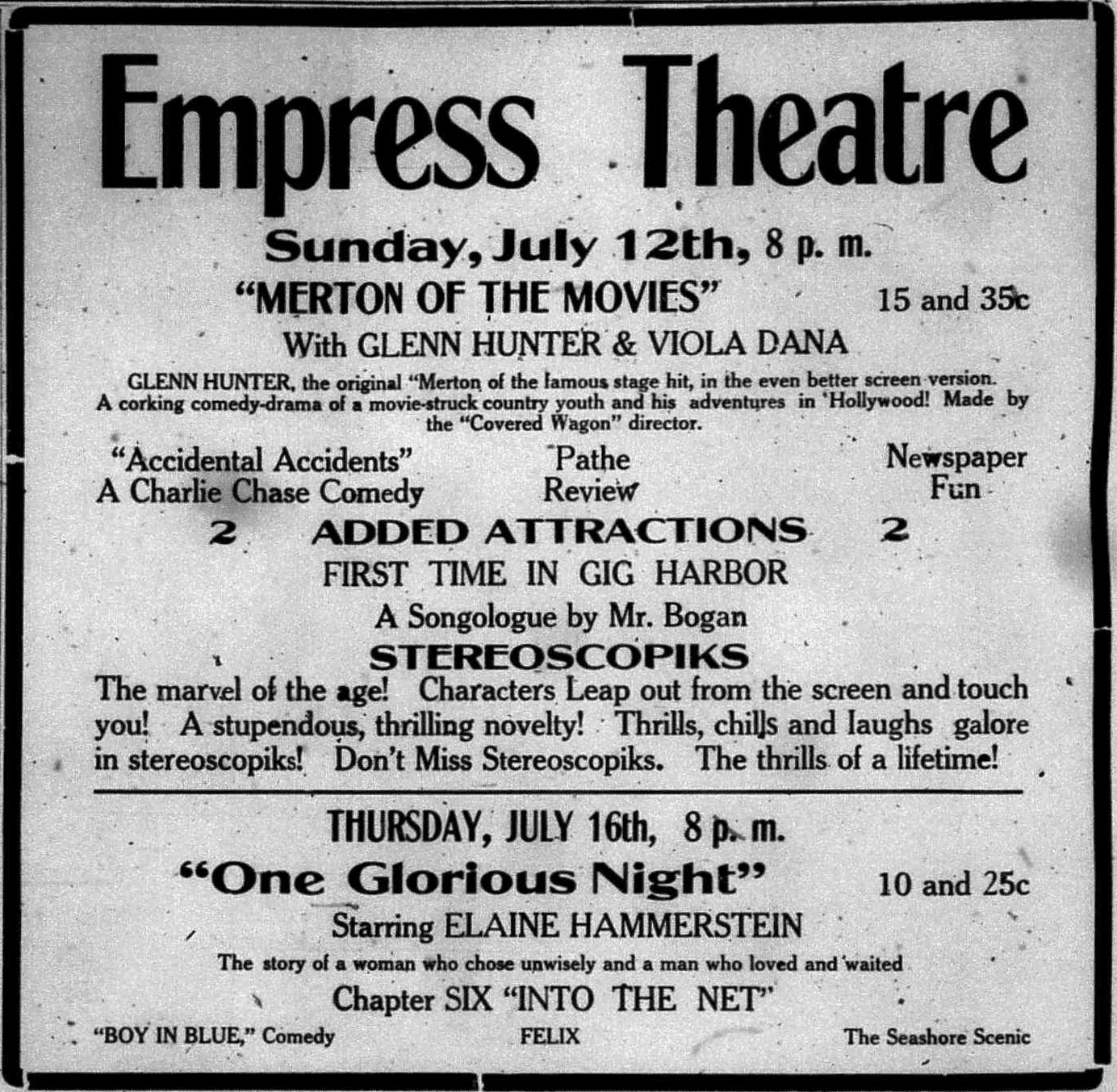
As advertised in the July 10, 1925 Peninsula Gateway, the first 3-D movie shown in Gig Harbor was last on a bill of six, immediately following a live act. Admission to the full night of entertainment cost 15 cents for children, 35 cents for adults.
Viewing the Stereoscopiks 3-D films required wearing the well-known and well-mocked glasses with the red and blue lenses. But look what wearing the goofy specs promised: A stupendous, thrilling novelty! Thrills, chills, and laughs galore! The thrills of a lifetime!
Who could possibly resist all that? (Oh, maybe anyone who knew someone else who’d paid fifteen or 35 cents to see how crummy it was.)
The Empress showed the second film in the Stereoscopiks series, “Zowie,” on Aug. 30, 1925, and the fourth, “Ouch,” in January 1926. (A screening date for the third film in the series, “The Runaway Taxi,” couldn’t be found.)
Gig Harbor was not spared from the resurgence of the 3-D fad in the 1950s. In January, 1953, the same theater, long since renamed the Roxy, showed “A Day in the Country” “in 3rd dimension.”
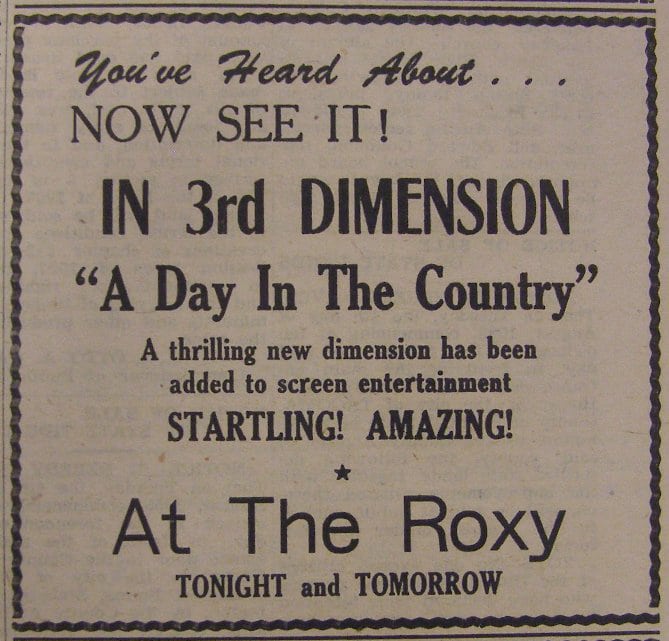
An otherwise silent film narrated by Joe Besser (who later replaced Shemp Howard in The Three Stooges), “A Day in the Country” was produced in 1941 but not released until the 3-D fad of the 1950s.
Second question: Where was Gig Harbor’s Empress (later Roxy) Theatre located?
Answer: On the mostly vacant lot at 3120 Harborview Drive, next to the Heritage Distilling Company.
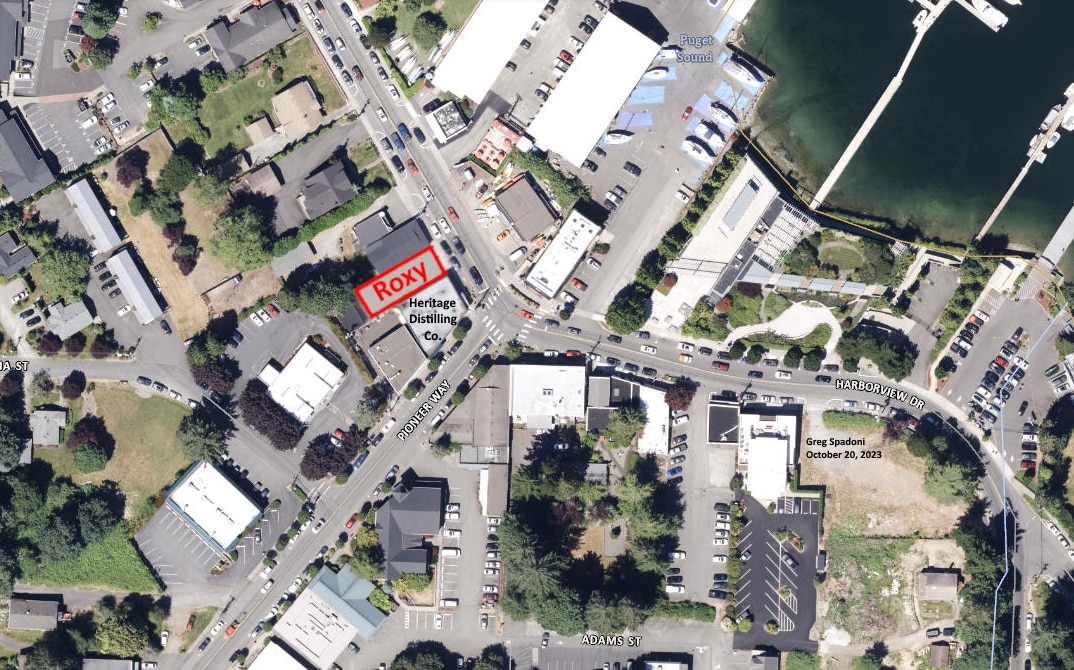
Gig Harbor’s first movie theater occupied the mostly vacant lot next to the Heritage Distilling Co. on Harborview Drive for 39 years. Pierce County Assessor-Treasurer aerial base map.
Third question: When was Gig Harbor’s original movie theater torn down?
Answer: 1964.
It was old, it was dilapidated, it was an attractive nuisance to kids, so it had to go. And it went.
The odd part of its demise is that no building has replaced it in the 59 years since. Why? Gig Harbor’s such a busy place that it seems very strange that a mostly vacant lot on the main drag hasn’t been redeveloped. (The small building at the back of the lot today, currently the Woodstock Gift Gallery, was already there when the theater was torn down.)
Is the site haunted? Well, yeah, maybe. There are indeed known ingredients for a haunting there. And this being the last week of October, it’s a great time to detail those ingredients. But look at the calendar— our next column isn’t until Nov. 6, way too late for Halloween. Unfortunately, the timing just won’t allow it.
Although this column is moving on to a new topic in the next paragraph, Gig Harbor Now is not finished with the theater’s history. Ed Friedrich has written a very interesting story on its last projectionist. It debuts later this week. The story has fascinating details about the operations of the Roxy in the late 1950s. I, for one, will be reading it with great interest … OK, so maybe I’ve already read it with great interest, which is why I know it’s so interesting.
From 3-D to trees
We now return from escapism at the movies to local history in real 3-D. No goofy two-toned glasses required. (However, a visit to Donkey Creek Park is required to see this week’s topic in real 3-D.)
Contrary to what’s been written far, far, far too many times, the first big industry in Gig Harbor was logging, not fishing. Commercial fishing’s time would come, but for the first 50 or more years of non-native settlement, the timber industry was king.
In the early years of local logging, only two species of trees were cut: Douglas fir and western red cedar. A market for hemlock didn’t develop until after the turn of the 20th century.
The virgin Douglas fir covering the Gig Harbor and Key peninsulas was impressive by today’s standards, although the trees weren’t nearly as big as in the forests further inland, nearer the mountains.
There are still today a very few small pockets of virgin timber on the peninsulas, but the overwhelming majority of trees are second growth. In this installment of Gig Harbor Now and Then, we’re going to take a brief look at one of the second-growth Douglas firs.
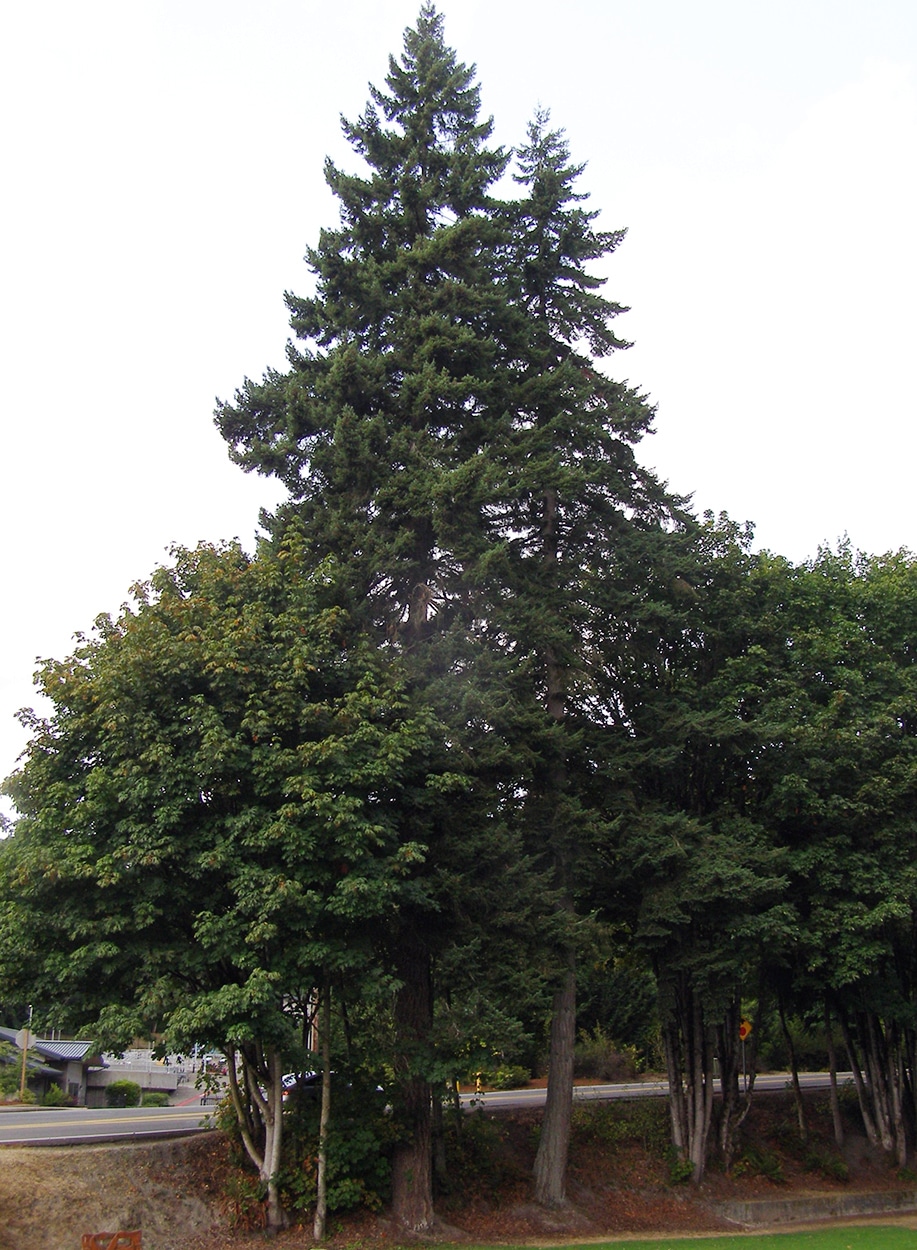
The taller of these two beautiful Douglas firs in Donkey Creek Park is the subject of today’s Gig Harbor Now and Then column. Photo by Greg Spadoni.
Gig Harbor’s Donkey Creek Park includes some very nice trees, mostly big leaf maple, Douglas fir, and western red cedar. On the west side of the park, lining Harborview Drive, are two fine examples of second-growth Douglas fir. The southernmost and tallest of the two is 47 inches in diameter, measured at four and a half feet above the ground. That’s rather thick by today’s standards. In the days of the local old-growth forest, it would be no more and no less than average. The tree is about 136 feet tall, which is almost big in the modern world. But that height would rank quite low on the scale of local old growth.
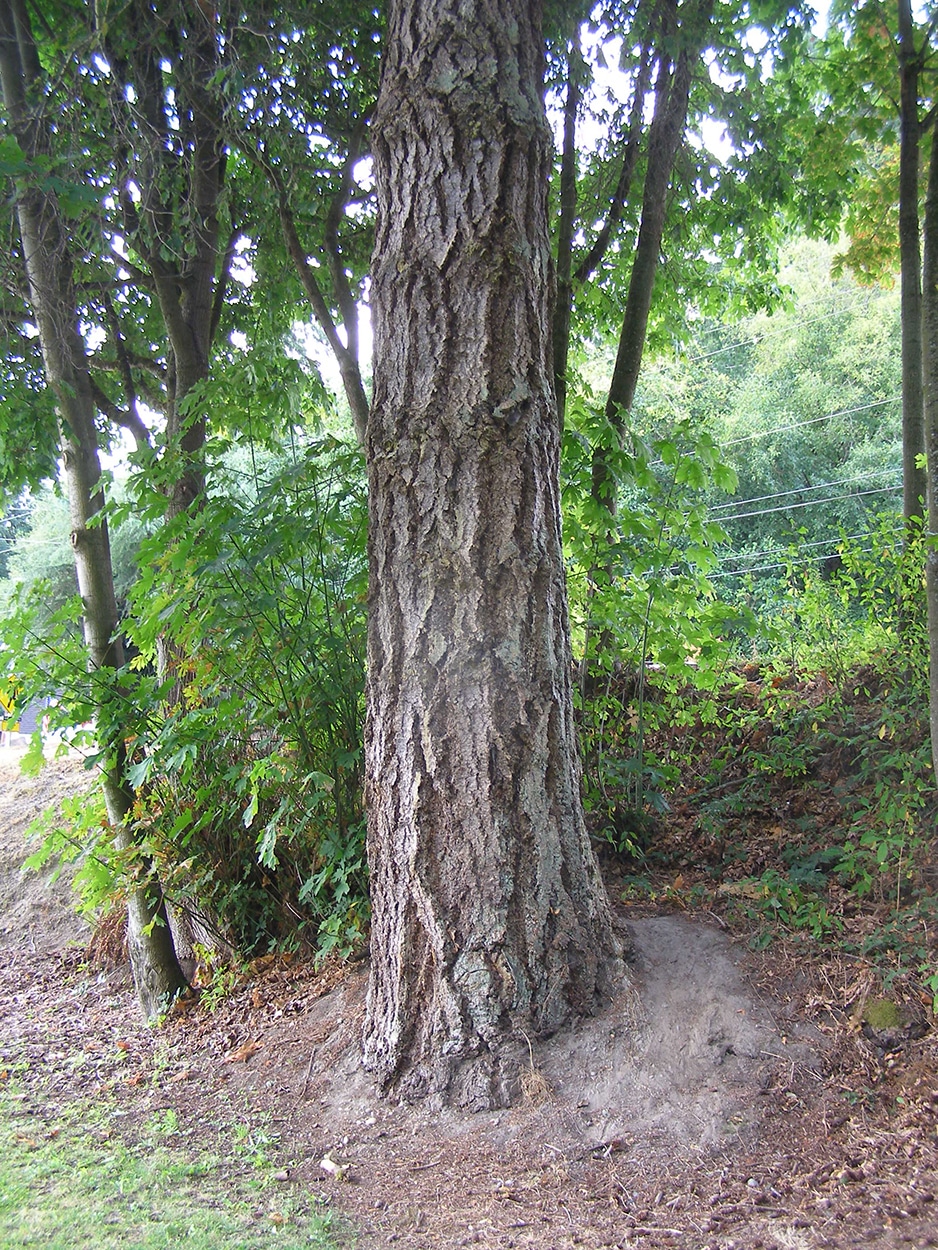
The trunk of the tree in question is 47 inches in diameter. Photo by Greg Spadoni.
Two more comparisons of the Donkey Creek Park fir to the trees of the local old growth of yesteryear are addressed in this week’s questions.
1. How old is the Donkey Creek Park fir tree?
We’re not looking for a specific number of years, just a general age range. Keep in mind it’s only one inch shy of four feet in diameter and about 136 feet tall.
2. In dollars, how much would today’s Donkey Creek Park fir have been worth if it was its present size in 1900?
(An on-site visual inspection would really help with the answers to this question.)
The degree of difficulty of today’s questions are probably a 4 (out of 5), but only for non-loggers. For loggers, they’re both a 1.
Gig Harbor Now and Then will have the answers on Nov. 6. Until then, you’re invited to visit the Gig Harbor Now Facebook page and post your guesses on the age and value of the Donkey Creek Park Douglas fir tree.
It might be helpful to know the duration of the “general age range” we’re looking for. Twenty years seems unreasonably small for such a big tree. How about 50? That sounds reasonable. Within a 50-year window, how old is the tree in question?
As for the value, how about within 20 dollars, not adjusted for inflation?
Comments on crummy 3-D movies are also welcome. Since the 1990s or so, there have been some very good 3-D effects in movies, especially in animated films. But we’re talking about the 1920s to 1950s movies, several of which were shown in Gig Harbor. Has anyone seen a 1950s or earlier 3-D film they’d be willing to pay to see again? Would you be willing to pay as much as 35 cents?
Greg Spadoni of Olalla has had more access to local history than most life-long residents. During 25 years in road construction working for the Spadoni Brothers, his first cousins, twice removed, he traveled to every corner of the Gig Harbor and Key Peninsulas, taking note of many abandoned buildings, overgrown farms, and roads that no longer had a destination. Through his current association with the Harbor History Museum in Gig Harbor as the unofficial Chief (and only) Assistant to Linda McCowen, the Museum’s primary photo archive volunteer, he regularly studies the area’s largest collection of visual history. Combined with the print history available at the Museum and online, he has uncovered countless stories of long-forgotten local people and events.

